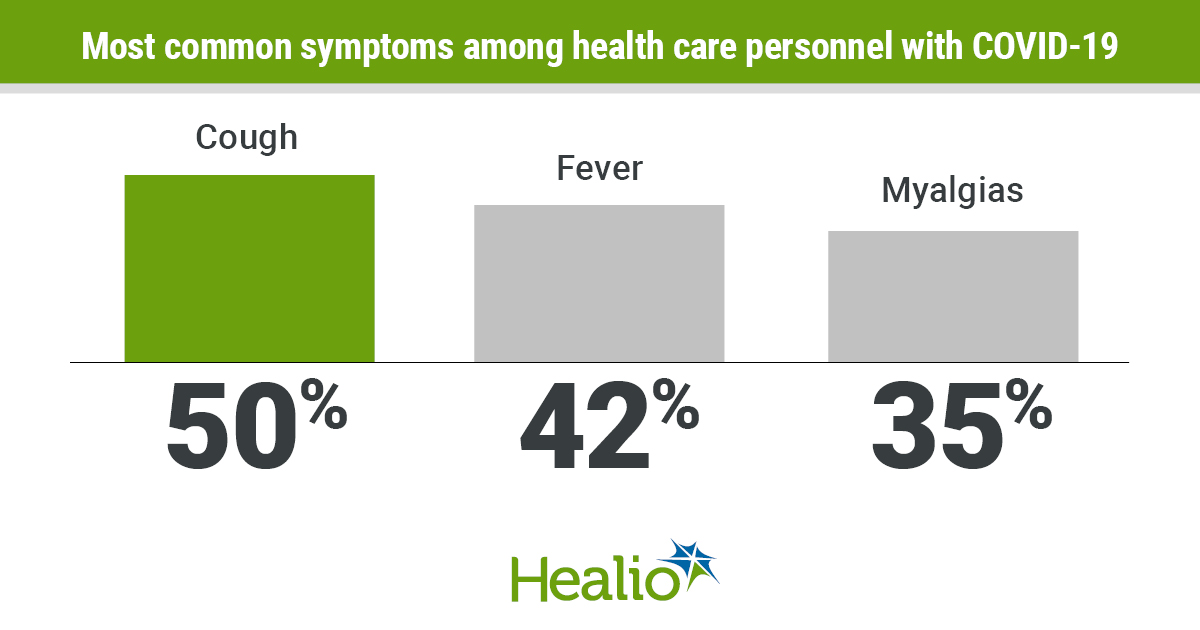Screening for only common COVID-19 symptoms may miss symptomatic cases among HCP

Screening only for cough, shortness of breath, fever or sore throat may have missed 17% of symptomatic health care personnel, or HCP, with COVID-19, according to a JAMA study — suggesting a need to expand symptom-based screening criteria for HCP.
“Health care personnel with COVID-19 may have symptoms other than fever or respiratory symptoms at illness onset,” Eric J. Chow, MD, MS, MPH, of the CDC’s Epidemic Intelligence Service and the National Center for Immunization and Respiratory Disease’s Influenza Division at the CDC, told Healio. “Health care personnel should be reminded to stay home when they are ill. If health care personnel develop fever or symptoms consistent with COVID-19 while at work, they should keep their cloth face covering or face mask on, inform their supervisor and leave the workplace.”
Chow and colleagues examined lab-confirmed SARS-CoV-2 infections in HCP in King County, Washington, from Feb. 28, 2020, when the first confirmed case was detected in a King County long-term care facility, to March 13, 2020. Personnel were tested after meeting their individual facilities’ signs and symptoms criteria for testing. Researchers conducted phone interviews to obtain information about demographics, chronic medical conditions (including obesity, hypertension, diabetes and hepatic, cardiac and pulmonary disease), types of patient care, symptom history, occupation and work location, days worked while symptomatic and clinical outcomes from personnel.
A total of 48 HCP were interviewed, 37 (77.1%) of whom performed direct patient care. Nearly half (47.9%) reported chronic medical conditions. Overall, the HCP worked in 22 health care settings, including long-term care facilities (50%), outpatient clinics (27.1%) and acute-care hospitals (12.5%).

The most frequently reported initial symptoms were cough (50%), fever (41.7%) and myalgias (35.4%). A total of eight (16.7%) HCP did not report cough, fever, shortness of breath or sore throat at symptom onset; chills, myalgia, coryza and malaise were the most common symptoms in this group. If myalgias and chills were included in screening criteria at the time of illness onset, the identification of cases among HCP went from 40 (83.3%) to 43 cases (89.6%).
“Symptom screening also will not identify individuals who are infected but otherwise asymptomatic or presymptomatic,” Chow said. “Additional interventions are needed to limit the unrecognized introduction of SARS-CoV-2 into health care settings by these individuals. As part of aggressive source control measures, health care facilities should consider implementing policies requiring everyone entering the facility to wear a cloth face covering (if tolerated) while in the building, regardless of symptoms.”
Chow noted that one of the study’s limitations was that HCP were tested only after meeting their facilities’ symptom criteria, which varied.
“It is likely that this study underestimated the number of health care personnel with COVID-19 who were asymptomatic or had ‘atypical’ symptoms,’” Chow said. “Future studies should take a systematic approach to testing health care personnel to better understand the full range of symptoms that may be associated with COVID-19.”– by Eamon Dreisbach
Disclosure: The researchers report no relevant financial disclosures.

